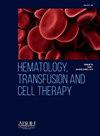IF 1.8
Q3 HEMATOLOGY
引用次数: 0
摘要
导言/理由一个多世纪以来,各种常微分方程生长模型一直被用于描述和预测人类恶性肿瘤的增殖。事实上,在数学肿瘤学领域,细胞群随时间的增长通常用西格玛函数来表示,如 logistic 或 Gompertz 曲线及其广义。这些模型尤其侧重于理解和预测癌细胞的增殖,包括人类胶质母细胞瘤细胞的增殖,胶质母细胞瘤是一种侵袭性很强的脑肿瘤,存活率不到两年。这项研究利用真实数据集的曲线拟合和数值参数估计对五种人类胶质母细胞瘤细胞系的体外细胞培养进行了研究,以分别描述所有这些细胞系随着时间推移的生长曲线。这些实验包括一个成熟的人类胶质母细胞瘤细胞系(NG97)和其他四个来源于临床患者的胶质母细胞瘤细胞系,分别命名为 N07、C03、L09 和 J01。每种细胞系重复进行了 12 次实验。细胞计数在第 1 至 6 天每天进行。使用 drda R 软件包对测量数据进行曲线拟合,以确定五种细胞系的内在生长率和其他参数。结果曲线拟合分析表明,不同细胞系的群体生长具有显著的多样性。drda R软件包被证明能非常有效地捕捉这些不同的行为以及与之相关的独特的西格玛形状。值得注意的是,NG97 细胞的群体生长随时间的变化最小,拟合曲线及其相关参数的置信区间最窄。这种一致性可归因于 NG97 是一种成熟的细胞系。相比之下,新的患者衍生细胞系显示出更大程度的不确定性,尤其是当其置信区间推断超过最后一天的测量时。结论根据数值和图形结果、AIC 和 BIC 指标以及各自提供的不确定性水平,拟合模型对所有研究过的胶质母细胞瘤细胞系都进行了合理的生长描述,无论细胞系是成熟的(NG97)还是新来源于人类患者(N07、C03、L09 和 J01)。这些结果与预后和临床之间的进一步关联可能对转化肿瘤学具有重要价值。本文章由计算机程序翻译,如有差异,请以英文原文为准。
IN VITRO POPULATION GROWTH OF HUMAN GLIOBLASTOMAS: REAL PATIENTS AND CURVE FITTING
Introduction/Justification
For more than a century, a variety of ordinary differential equation growth models have been used to describe and predict the proliferation of human malignancies. Indeed, in the field of mathematical oncology, the growth of cell populations over time is typically represented by sigmoidal functions, such as logistic or Gompertz curves and their generalizations. These models are particularly focused on understanding and predicting the proliferation of cancer cells, including those from human glioblastomas, which can be very aggressive brain tumors with a survival rate of less than two years.
Objectives
This research examines in vitro cell cultures of five lines of human glioblastoma using curve fitting and numerical parameter estimation of real datasets to separately describe the growth profile of all these cell populations lineages over time.
Materials and Methods
Cell culture experiments were performed in the Advanced Therapeutics Laboratory at FCF-UNICAMP. These included a well-established human glioblastoma cell line (NG97) and four other glioblastoma cell lines derived from clinical patients designated N07, C03, L09 and J01. Twelve repeated time series of experiments were collected for each cell line. Cell counting was performed daily on days 1 to 6. The drda R package was used for curve fitting of the measured data aiming to determine the intrinsic growth rate and other parameters for each of the five cell lines. The 5-parameter generalized logistic curve was used, and all the resulting models were analyzed under statistical criteria such as the Akaike Information Criterion (AIC) and the Bayesian Information Criterion (BIC).
Results
Curve fitting analysis revealed significant diversity in the population growth of different cell lines. The drda R package proved to be highly effective in capturing these different behaviors and the unique sigmoidal shapes associated with them. Notably, the population growth of NG97 cells showed the least variability over time, with the narrowest confidence intervals for the fitted curves and their associated parameters. This consistency can be attributed to the fact that NG97 is a well-established cell lineage. In contrast, the new patient-derived cell lines showed a greater degree of uncertainty, particularly when their confidence intervals were extrapolated beyond the last day of measurement. This observation highlights the need for additional time points in in vitro experiments with newly derived human patient cells.
Conclusion
According to the numerical and graphical results, to AIC and BIC metrics, and also to the respective levels of provided uncertainty, the fitted models present a reasonable growth description of all the studied lineages of glioblastoma, regardless of cell line being well-established (NG97) or newly originated from human patients (N07, C03, L09, and J01). Further correlations between those results and prognostics and clinics may be of value for translational oncology.
求助全文
通过发布文献求助,成功后即可免费获取论文全文。
去求助
来源期刊

Hematology, Transfusion and Cell Therapy
Multiple-
CiteScore
2.40
自引率
4.80%
发文量
1419
审稿时长
30 weeks
 求助内容:
求助内容: 应助结果提醒方式:
应助结果提醒方式:


